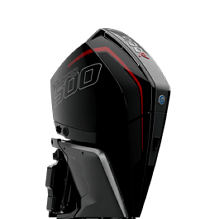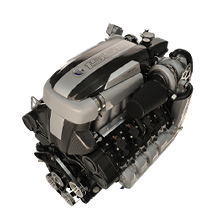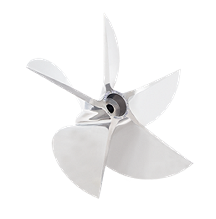Mercury Racing Blog
Prop School – Part 5: Blade Efficiency
Thu Jan 31 12:30:00 CST 2019

Rotation. Propellers come in both right and left-hand rotation. Standard rotation for both outboards and sterndrives is right-hand: the prop spins clockwise when in forward gear. Left-hand props spin counter clockwise. Left-hand props are typically used with multi-engine applications. The counter-rotation prop works to balance (or reduce) the torque effects from the right-hand prop. Most twin engine applications are setup with the props “turning in”; the port engine spinning right-hand and the starboard engine spinning counter clockwise.
Hull types and designs respond differently to prop rotations. Some need additional stern lift to reach maximum efficiency and performance. To obtain this, the rotation of both propellers is set up, so they rotate away from each other. We call this turning the props out. The left-hand rotation prop is on the port side and the right-hand rotation is on the starboard side.
For example, a high-speed catamaran loaded with gear and passengers often runs best with 5-blade cleaver props with 15-degree rake. Turning the props in pulls the stern down, enabling the boat to float over chop. With lighter loads and ideal conditions, the same cat can gain 6 to 8 mph when using 18-degree rake, 5 blade cleavers “turned-out.”
Number of Blades
In theory, two blade props are most efficient since they have the least amount of surface dragging through the water. Two blade props are commonly used on lower horsepower outboards and trolling motors. Three -blade and four-blade props are the most common designs used today. The added blades reduce vibration while maintaining most of the efficiency of a two-blade design at a convenient size and reasonable cost.
Racers and performance boaters raise sterndrive mounting heights (x-dimensions) on ventilated, stepped hulls. The steps create air bubbles, raising the hull off the water on a drag-reducing cushion. This, combined with reduced drag from the higher drive heights, improves hull efficiency. This trend has spawned an evolution of prop designs featuring four, five and even six blades. The additional blade surface helps offset slip induced by air bubbles flowing from the ventilation steps toward the props.
Blade Thickness
For efficiency, blades should be as thin as possible to reliably handle a particular power range. A cross section of a typical constant pitch prop blade reveals a flat section on the positive (pressure) side and an arc surface on the negative (suction side) of the blade. Edges are usually 0.06″ to 0.08″ (1.5 mm to 2.0 mm) thick for aluminum props, thinner for stainless steel.

The blade cross section on surfacing props such as our T.E. Cleaver and Pro Finish CNC Cleavers is wedge shaped. The thick trailing edge adds strength. Surface air ventilates a low-pressure cavitation pockets behind the trailing edge, enhancing efficiency. The contour or shape of most propeller blade tips (other than cleaver) are round.
I will discuss propeller slip more thoroughly in Prop School – Part 6.


